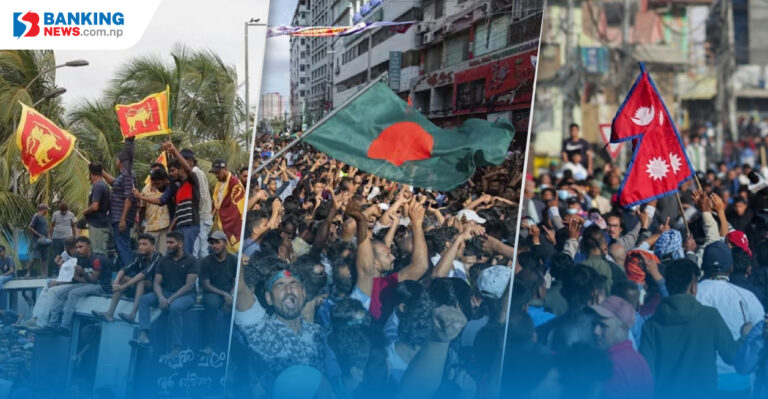After the Gen-Z uprising against corruption, Nepal has entered a new political chapter. The interim government, formed in the wake of the movement, now faces the dual responsibility of preparing for elections and reviving the faltering economy. While the political shift has sparked public hope, achieving tangible economic recovery remains the nation’s biggest challenge.
Lessons from Regional Neighbors
The experiences of neighboring South Asian nations such as Bangladesh and Sri Lanka offer valuable insights for Nepal. Both countries faced political instability and economic crises but managed to revive their economies through policy reforms, investment in production, and effective use of foreign assistance.
Since 2022, three South Asian governments have fallen amid waves of public uprisings. In April 2022, the Rajapaksa family was ousted in Sri Lanka; in August 2024, Sheikh Hasina’s government in Bangladesh collapsed under similar public pressure. Inspired by these movements, Nepal too saw massive public unrest that forced Prime Minister KP Sharma Oli to resign on September 10, 2025.
Currently, South Asia is experiencing one of the most volatile political transitions in its modern history. Despite significant economic growth in the past decade moving from least developed to developing status these nations now risk losing momentum due to political upheaval and insufficient focus on economic management.
According to the World Bank, political instability, global trade tensions, and sluggish investment have slowed regional growth. Additionally, rising debt burdens have made many South Asian economies vulnerable to interest rate shocks and fiscal imbalance.
Sri Lanka’s Economic Turnaround
In 2022, Sri Lanka plunged into its worst-ever economic crisis since gaining independence in 1948, leading to mass protests and the fall of the Rajapaksa regime. The crisis stemmed from heavy foreign debt, inflation, and fuel shortages. The government even struggled to fund basic needs like school exams and medicine.
The collapse of the tourism sector, a key foreign currency earner before COVID-19, deepened the crisis. But by 2025, Sri Lanka has shown strong signs of recovery. In the second quarter of 2025, it recorded 4.9% GDP growth, similar to the same period in the previous year.
Fuel prices have declined, and the Sri Lankan rupee has stabilized. The central bank’s monetary easing has improved banking profits and capital adequacy, driving stock markets to record highs. Revenue collection and structural reforms are underway, supported by tourism recovery and remittance inflows both critical to stabilizing the economy.
Sri Lanka is now emerging as South Asia’s second-largest IT exporter after India, signaling a shift toward long-term economic sustainability.
Bangladesh: Struggling Amid Political Uncertainty
Post-political transition, Bangladesh’s economy is grappling with uncertainty. Once exporting over $40 billion annually in garments, it faced a sharp slowdown, with growth dipping to around 2% by mid-2024. However, by early 2025, the economy rebounded to 4.9% growth, signaling partial recovery.
Inflation remains high at over 8.3%, prompting the Bangladesh Bank to tighten monetary policy. Although interest rates have eased to around 3%, boosting business activity, investment inflows remain weak due to political instability.
The banking sector is burdened with rising non-performing loans (NPLs), while the private sector struggles with limited credit access. Unemployment and declining remittances have reduced domestic consumption.
Nevertheless, export performance is improving, and the Bangladeshi taka remains stable. The garment industry, contributing nearly 10% of GDP, is regaining momentum. Continued trade privileges for least developed countries until 2029 could help Bangladesh maintain economic resilience.
Nepal’s Position: Between Hope and Caution
According to the World Bank, Nepal’s economic growth for the current fiscal year is projected at 2.1%, down from earlier estimates. In contrast, Sri Lanka is expected to grow by 3.5% and Bangladesh by 4.8%.
Economist Dr. Dilli Raj Khanal says comparing Nepal’s Gen-Z movement with Sri Lanka or Bangladesh is misleading:
“Sri Lanka’s crisis was primarily economic, while Nepal and Bangladesh underwent political shifts,” he explained to Banking News Nepal.
Still, he noted that Sri Lanka’s rapid recovery offers lessons particularly how progress in tea exports, tourism, and IMF-backed reforms revitalized the economy.
Khanal estimates Nepal incurred over NPR 150 billion in losses during the recent uprising. “The government must first rebuild private sector confidence, then focus on reconstruction, peace, and investment assurance,” he advised, recalling Nepal’s post-earthquake rebound when GDP growth exceeded 7% for three consecutive years.
Risks Ahead for Nepal
ADB economist Manav Khadka urges Nepal to learn from both the successes and failures of Sri Lanka and Bangladesh. He warns that ongoing instability could threaten foreign investment and remittance inflows, the backbone of Nepal’s economy.
Following the unrest, several Gulf countries, including the UAE, have suspended visit visas for Nepalis and tightened work migration policies. If similar restrictions expand, remittance inflows Nepal’s largest source of foreign currency could shrink, straining foreign reserves and triggering an economic downturn similar to Sri Lanka’s.
Moreover, concerns over security and law enforcement could deter foreign tourists and investors, undermining the fragile recovery in tourism and FDI inflows.
“The state must first convince the international community that Nepal is safe for travel and investment,” Khadka emphasized, adding that recovering stolen weapons and re-arresting escaped prisoners are key steps toward restoring confidence.
The Road Ahead
For Nepal, the immediate priority is to restore economic confidence, ensure stability, and signal policy clarity to domestic and foreign stakeholders. The stories of Sri Lanka’s disciplined recovery and Bangladesh’s cautious rebound underscore one truth:
political change alone doesn’t guarantee economic revival, sustained policy action does.



 About Us
About Us
Comment